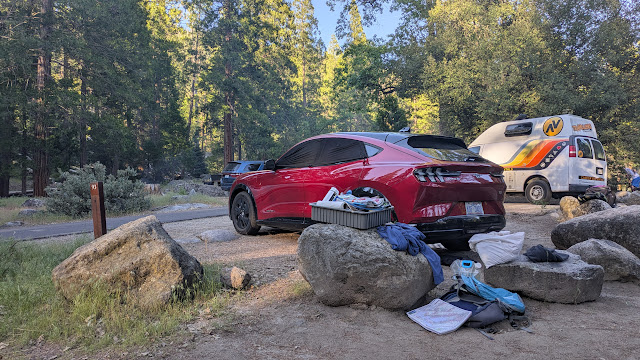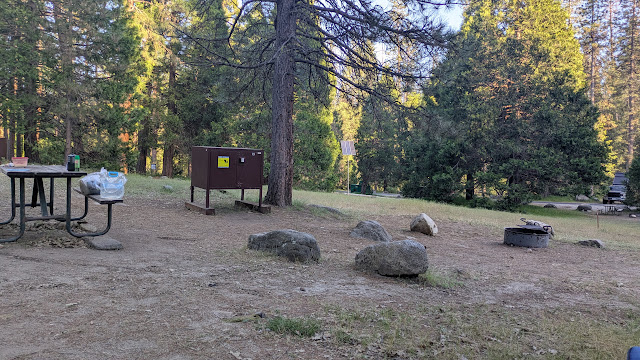On Wednesday morning, we were up by 6:30 to make sure we wouldn't have any issues getting into the park. As we approached Yosemite, we first considered seeing the Mariposa Sequoia grove but decided we would put that off since we had just been to Sequoia/Kings Canyon NPs. We spotted a few mule deer, snapped some quick photos and moved on Yosemite Valley, the heart of the park. The wildlife sightings over the next three days were disappointing. We didn't see any more large wildlife except a few condor sightings.
We stopped for a cool waterfall as we approached the valley (unnamed as far as we know), then continued on to the valley. This initial sighting of a strong waterfall was a hint of what was to come when we reached the valley - spring snowmelt makes for amazing views of beautiful, long waterfalls. We were very fortunate to visit Yosemite at this time of year.
 |
| Beautiful waterfall that came down the mountainside on the road into the park. This is looking up the waterfall. |
 |
| The water flowed under a bridge - this is looking down the waterfall on the other side of the road. |
We had left the sandstone and red rocks of Utah and Arizona behind. We were in granite world now. I had a lot of questions in my mind about how this rock was initially formed, so here is an excerpt from the NPS website that summarizes:
"The granites of Yosemite are part of the Sierra Nevada Batholith, a large amalgamation of plutons. Plutons are bodies of molten rock material (magma) that froze within the Earth rather than erupting to form volcanic rocks. The batholith formed due to subduction, where tectonic plates converge and one dives under the other. Around 220 million years ago, the ancestors of the Pacific Plate began to subduct beneath the North American Plate and the west coast of California was similar to today's Andes of South America. The majority of granites in Yosemite National Park formed during the Cretaceous period, between 105 and 85 million years old. They were eventually exposed on the surface by gradual erosion of the overlying rocks over millions of years. The huge amount of eroded sediment was transported westward by river systems into California’s Central Valley.
The sheer cliffs of Yosemite Valley, the spire-like peaks of the high country, and the many rounded domes all result from the fact that granite is very strong: it is an unlayered rock that due to its massiveness and durability can sustain bold forms. Large interlocking crystals form as magma very slowly cools to create granite, which is why it is one of the strongest types of rock. The vertical face of El Capitan, rising 3,000 feet above the floor of Yosemite Valley, testifies to the great strength and relative lack of fractures in the El Capitan Granite. It's a remarkable example of a granitic landform, composed of contrasting compositions and colors of plutonic rocks."
 |
| One of the many massive granite formations we saw as we entered Yosemite Valley. |
 |
| El Capitan |
The sights were truly breathtaking as we saw Bridal Veil Falls, then El Capitan, Yosemite Falls, Sentinel Dome, and Half Dome. It's easy to see why the valley is so popular. No hikes were required for these magnificent sights.
 |
| Merced River in the foreground, with Cathedral Peaks behind. This stands across from El Capitan |
 |
| Another view of El Capitan |
 |
| Valley view with Half Dome in the middle |
We made our way to the visitor's center for information and a recharge. There we learned there are more than 40 medium chargers in the park so we wouldn't have to worry about charging. We also got some recommendations and information on hikes for the next three days.
We started with a few easy hikes, first was Yosemite Falls hike. This easy one-mile paved walk gave the close-up view of the upper, middle, and lower falls.
Next we did a meadow walk which was peaceful and flat. Everywhere we looked there was another amazing sight.
We had lunch at the grill then drove to a nearby bus stop take the shuttle to another part of the valley. We ended up at a fairly quiet beach on the Merced River, where we relaxed for a bit before taking the bus tour of the rest of the valley. We ended up at our car again and decided to head to our campsite in Wawona, which is in the park but outside of the valley.
This drive was about 45 minutes as that is in the south end of the park. We found our campsite and there were no issues except that it wasn't level. We backed into our space so that our heads would be higher than our feet. The evening was quiet; I made Japanese stir fry for dinner, and we were in bed by dark. It sure was nice not to be setting up our car in the dark!
 |
| Hanging out at our campsite in the Wawona Campground |
 |
| Me under the Sequoia that was in our campsite |
 |
| Our unlevel campsite - but the weather was gorgeous, and we were near the Merced River |
 |
| We had to follow strict food storage requirements to keep our food safe from bears (black bears; there aren't any grizzlies in Yosemite). Our cooler, all of our food, cooking stuff and toiletries had to be stored in that brown box except for when they were being actively used. |
 |
| Relaxing at camp before an early bedtime. |
























No comments:
Post a Comment